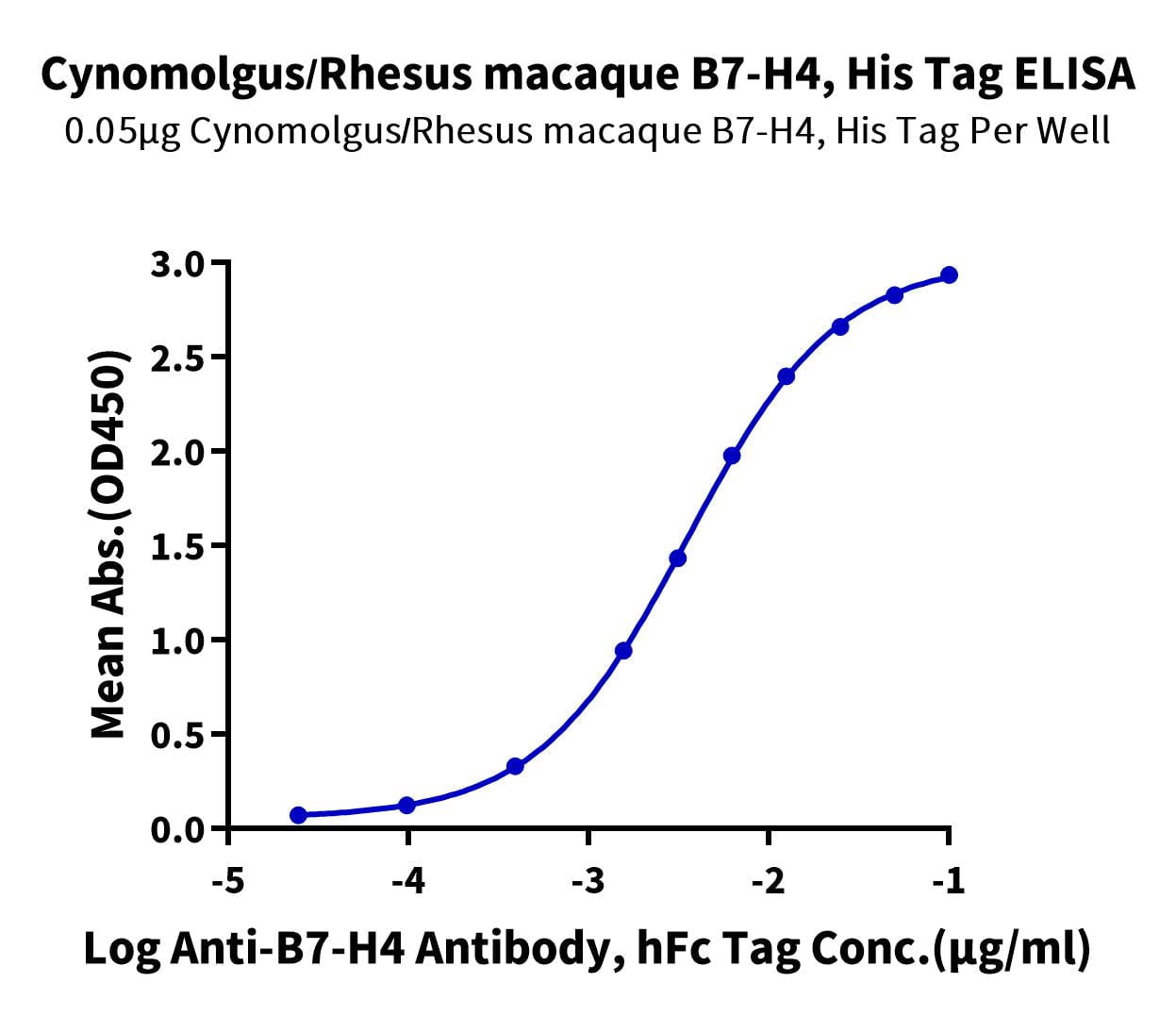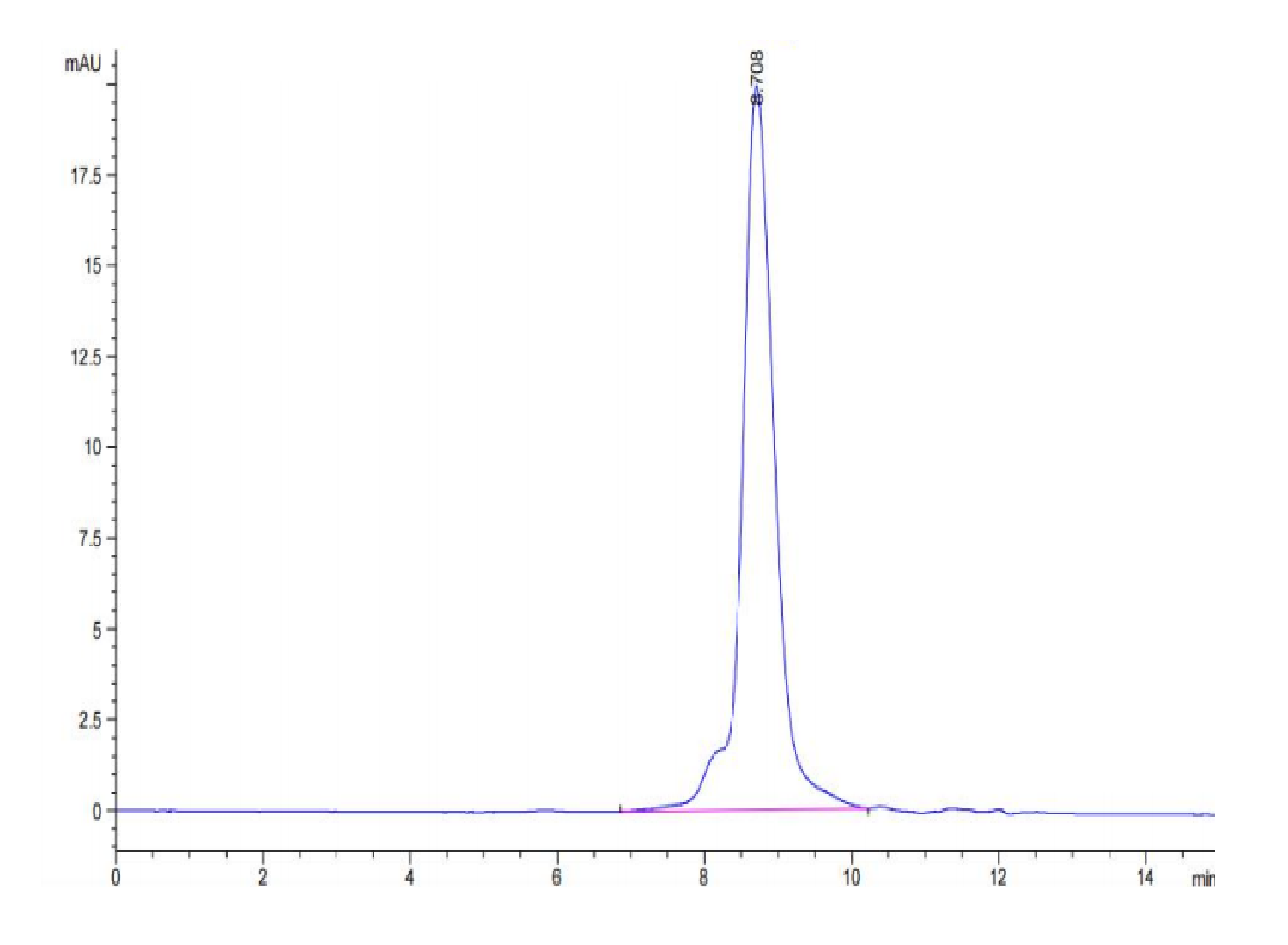| Weight | 1 lbs |
|---|---|
| Dimensions | 9 × 5 × 2 in |
| accession | A0A2K5U6P5 / F7B770 |
| express system | HEK293 |
| product tag | C-His |
| purity | > 95% as determined by Tris-Bis PAGE;> 95% as determined by HPLC |
| background | B7-H4, also known as B7x and B7S1, is a 50-80 kDa glycosylated member of the B7 family of immunomodulatory proteins.B7-H4 is up-regulated in several carcinomas in correlation with tumor progression and metastasis. A soluble form of B7-H4 is elevated in the serum of ovarian cancer, renal cell carcinoma, and rheumatoid arthritis patients, also in correlation with advanced disease status . |
| molecular weight | The protein has a predicted MW of 26.41 kDa. Due to glycosylation, the protein migrates to 48-63 kDa based on Tris-Bis PAGE result. |
| available size | 100 µg, 500 µg |
| endotoxin | Less than 1EU per μg by the LAL method. |
Cynomolgus/Rhesus macaque B7-H4 Protein 3150
$270.00 – $900.00
Summary
- Expression: HEK293
- Functional: Yes (ELISA)
- Amino Acid Range: Phe29-Ala258
Cynomolgus/Rhesus macaque B7-H4 Protein 3150
| protein |
|---|
| Size and concentration 100, 500µg and lyophilized |
| Form Lyophilized |
| Storage Instructions Valid for 12 months from date of receipt when stored at -80°C. Recommend to aliquot the protein into smaller quantities for optimal storage. Please minimize freeze-thaw cycles. |
| Storage buffer Shipped at ambient temperature. |
| Purity > 95% as determined by Tris-Bis PAGE |
| target relevance |
|---|
| B7-H4, also known as B7x and B7S1, is a 50-80 kDa glycosylated member of the B7 family of immunomodulatory proteins.B7-H4 is up-regulated in several carcinomas in correlation with tumor progression and metastasis. A soluble form of B7-H4 is elevated in the serum of ovarian cancer, renal cell carcinoma, and rheumatoid arthritis patients, also in correlation with advanced disease status . |
| Protein names V-set domain-containing T-cell activation inhibitor 1 (B7 homolog 4) (B7-H4) (B7h.5) (Immune costimulatory protein B7-H4) (Protein B7S1) (T-cell costimulatory molecule B7x) |
| Protein family Immunoglobulin superfamily, BTN/MOG family |
| Mass 30878Da |
| Function Negatively regulates T-cell-mediated immune response by inhibiting T-cell activation, proliferation, cytokine production and development of cytotoxicity. When expressed on the cell surface of tumor macrophages, plays an important role, together with regulatory T-cells (Treg), in the suppression of tumor-associated antigen-specific T-cell immunity. Involved in promoting epithelial cell transformation. {ECO:0000250|UniProtKB:Q7TSP5, ECO:0000269|PubMed:15878339, ECO:0000269|PubMed:16606666, ECO:0000269|PubMed:17509674, ECO:0000269|PubMed:17875732}. |
| Subellular location Cell membrane {ECO:0000255}; Single-pass type I membrane protein {ECO:0000305}. Note=Expressed at the cell surface. A soluble form has also been detected. {ECO:0000255, ECO:0000269|PubMed:12818165, ECO:0000269|PubMed:15878339, ECO:0000269|PubMed:16782226}. |
| Tissues Overexpressed in breast, ovarian, endometrial, renal cell (RCC) and non-small-cell lung cancers (NSCLC). Expressed on activated T- and B-cells, monocytes and dendritic cells, but not expressed in most normal tissues (at protein level). Widely expressed, including in kidney, liver, lung, ovary, placenta, spleen and testis. {ECO:0000269|PubMed:12818165, ECO:0000269|PubMed:14568939, ECO:0000269|PubMed:15878339, ECO:0000269|PubMed:16606666, ECO:0000269|PubMed:16782226, ECO:0000269|PubMed:16798883, ECO:0000269|PubMed:17509674}. |
| Post-translational modification N-glycosylated. {ECO:0000269|PubMed:15878339}. |
| Target Relevance information above includes information from UniProt accession: Q7Z7D3 |
| The UniProt Consortium |
Data
Publications
Publications
| pmid | title | authors | citation |
|---|---|---|---|
| We haven't added any publications to our database yet. | |||
Protocols
| relevant to this product |
|---|
Documents
| # | ||
|---|---|---|
| Please enter your product and batch number here to retrieve product datasheet, SDS, and QC information. | ||

















